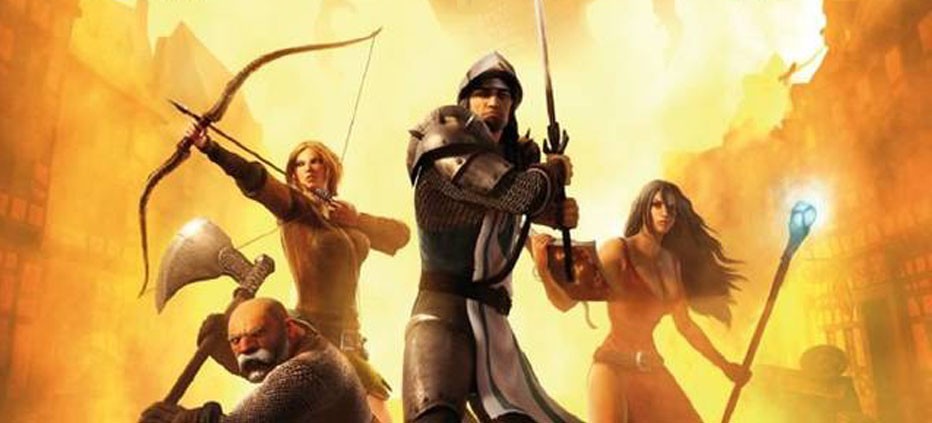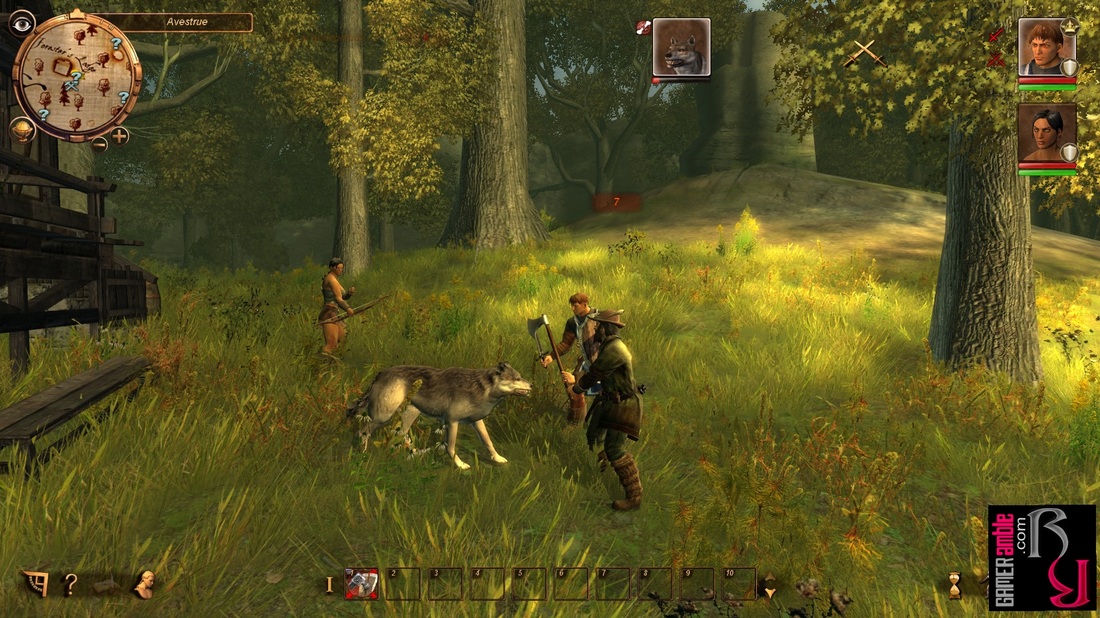Drakensang: The Dark Eye
Developer: Radon Labs | Publisher: DTP Entertainment | Release Date: 2009 | Genre: RPG | Website: n/a | Purchase: Steam
Based on a German tabletop game and featuring more generic fantasy cliches than you can shake a magical staff at, Drakensang is a role playing game of the kind that is becoming increasingly rare on PC. Think Baldur’s Gate and Icewind Dale mixed in with some Neverwinter Nights and you will have an idea what I am talking about. It never quite reaches the lofty heights attained by the aforementioned games, but it is pretty good in its own right.
After some character customization, which is more statistical than cosmetic, you are dropped in the gameworld of Aventuria with a quest to go visit an old friend that needs your help. In typical fantasy RPG fashion, you soon become embroiled in a prophecy that involves all manner of ancient evils. It is your job to save the world by destroying every monster and barrel in sight.
This isn’t the first time that players have been able to explore the world of Aventuria or “Arkania” as it is known in the “Northlands Trilogy” from the 90’s. If you are not familiar with the “Das Schwarze Auge” rule system, it can be a bit tricky to wrap your head around all the nuances. As someone who has played many Dungeons & Dragons titles, I thought it would be easy to get into this game but it was a bit of a struggle in the beginning. The game features a lot of combat and if you blunder into these situations unprepared, you will become very familiar with the “Game Over” screen. Drakensang is a game that revels in its complexity, so if you are used to the oversimplified console based role-playing games commonly found on PC these days this game is going to come as a bit of a shock. I mean when was the last time you had to use soap on your party members after an encounter with smelly amoebas. After each battle, I found myself having to cure varying degrees of poisoning and bandaging critical wounds before the adventure could continue. I am actually surprised that eating and sleeping is not a requirement for your characters.
Visually the game looks nice, but not quite what I would call cutting edge. The locations are all nice and detailed, but unfortunately, there is not much to see that most players will not have seen before. You have the same towns, sewers, caves and forests that have already been done to death. The same sense of deja vu befalls the creatures you face so expect the usual assortment of zombies, skeletons, giant spiders and rats that has been harassing adventures since the dawn of the fantasy genre.
Even the characters live up to their stereotypes so you have the gruff dwarves, haughty elves and bumbling wizards. At least the dragon theme provides a few cool moments. Overall Drakensang does not attempt to really add much to the genre and instead focuses on providing you a good adventuring romp in familiar surroundings. Speaking of surroundings, I would have liked to see a bit more interaction with the environments. While lush, everything feels very static and apart from bashing an endless amount of barrels your actions have very little impact on the gameworld. Merchants will not bat an eyelash while you break into and loot their storage chests and apart from pubs and temples, most buildings are inaccessible. Even the interaction between party members is very minimal, so if you are looking for something that offers the same emotional depth that Baldur’s Gate had this is not it. Since your characters can neither jump nor swim, the smallest obstacle can block their progress or force lengthy detours. This coupled with the maddeningly slow running speed can lead to some tedium.
Gameplay wise, Drakensang falls squarely into the “kill this, fetch that” category. There is a ton of side quests, but they all boil down to these same two elements. A handy journal helps you to keep track of it all thankfully. The vast array of fetch quests can become a bit tedious and the severe lack of worthwhile rewards just made it worse. It was not until very late in the game that I started seeing weapons and equipment that were special in some way. Since you are pretty much playing for experience to level up characters and fiddle with all their stats it can feel like a bit of a grind. It does not help that the story is very slow to get off the ground and isn’t particularly gripping either. It becomes a bit better towards the end so I recommend you stick with it. You will be spending most of your time engaged in combat and it requires a lot of attention as it is a lot more tactical than some players will be used to. Your position actually matters so attacking an enemy from the rear or flank will cause more damage and injuries. The same goes for your party members so get ready to have your weaker characters singled out and decimated. The game has an active pause feature, which allows you to reposition party members and issue new orders in the heat of battle. Believe me, this is something you will be using a lot as party members require quite a bit of babysitting in order to stay alive. It definitely keeps you on your toes, but can make most dungeons a big slog. At least you can save at any time as death occurs swiftly in this game if you do not pay attention.
I must say that I was impressed by the absence of bugs (the software kind) in this game. Apart from one line of untranslated text, I did not see anything out of the ordinary. No crashes, no freezes and no save game corruption. I found the camera to be a bit unwieldy, especially during combat and I had to constantly wrestle with it to get a good view of my surroundings. The audio is nice with most of the tunes being very moody or tranquil. I got a bit tired of the combat music towards the end however. The game features voice-overs, but it is reserved for cut-scenes and the first line of dialogue in conversations. While the voices are ok, I prefer reading as it speeds up the process and nobody had anything to say that was particularly gripping in any case. The shouts during combat become repetitive very quickly however. I ended up swapping my Amazon for another party member due to her constant shouts of “Drink blood my sword” despite being armed with a bow.
As refreshing as it was to play a game with party members again, I am afraid that none of them are very memorable. You can have up to three of them with you while the rest wait for you at your residence. I liked the fact that all of them earn experience as well, so when you swap out characters you are not left with weaklings. As much as I enjoyed playing the game, it all felt very by the numbers and I do not think that it has much replay value. While you are playing, there is a lot to see and do like crafting and alchemy, but make sure you are completely done with an area before leaving as they are usually closed off afterwards.
While Drakensang doesn’t offer much that hasn’t been seen a million times before it at least fills an ever widening gap in the market. With role-playing games either following the massive multi player online route or becoming oversimplified in order to be more accessible to console players it is at least heartening to see products like this still appearing on the market. It provided me with a stiff challenge and while I would not say that I was hooked, it at least made me care enough to stick with it to the very end. If you can put up with the rather steep learning curve and overlook the clichés you will find a traditional RPG like they just do not make anymore.
*Review originally published December 2011.
System Requirements
- OS: Windows XP / Vista
- Processor: Pentium® IV 2.4 GHz or better processor
- Memory: 1536 MB RAM
- Graphics: NVIDIA GeForce 6600 GT with 256 MB RAM or similar video card
- Hard Drive: 6 GB Hard Drive Space
- Sound: DirectX® 9c compatible sound card
- OS: Windows XP / Vista
- Processor: Intel® Core™ 2 Duo E8200 2.6 GHz or better processor
- Memory: 2 GB RAM for Windows® XP, 3 GB RAM for Windows® Vista
- Graphics: NVIDIA GeForce 8800 or similar video card
- Hard Drive: 10 GB Hard Drive Space
- Sound: DirectX® 9c compatible Sound Card






















